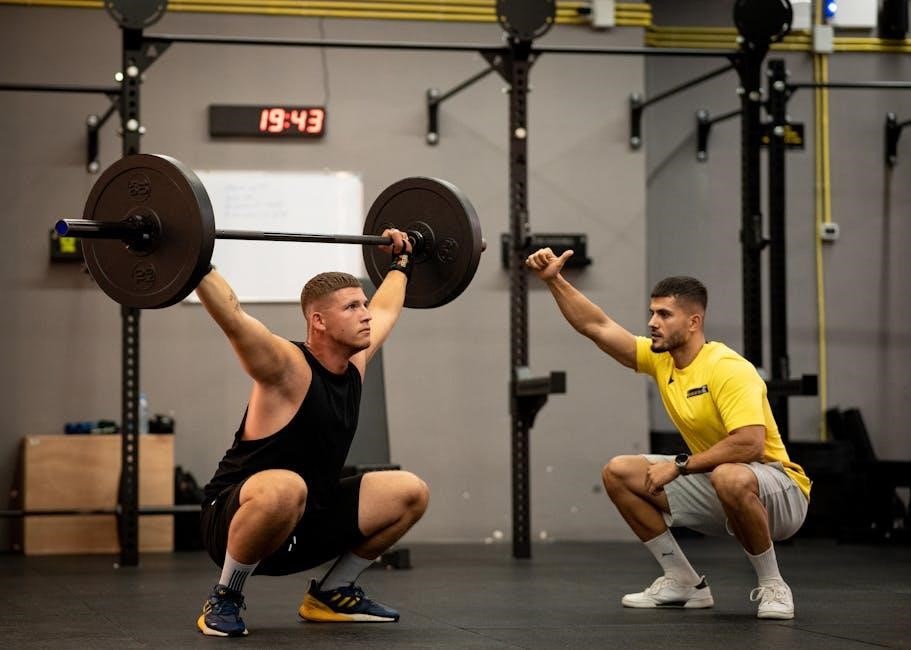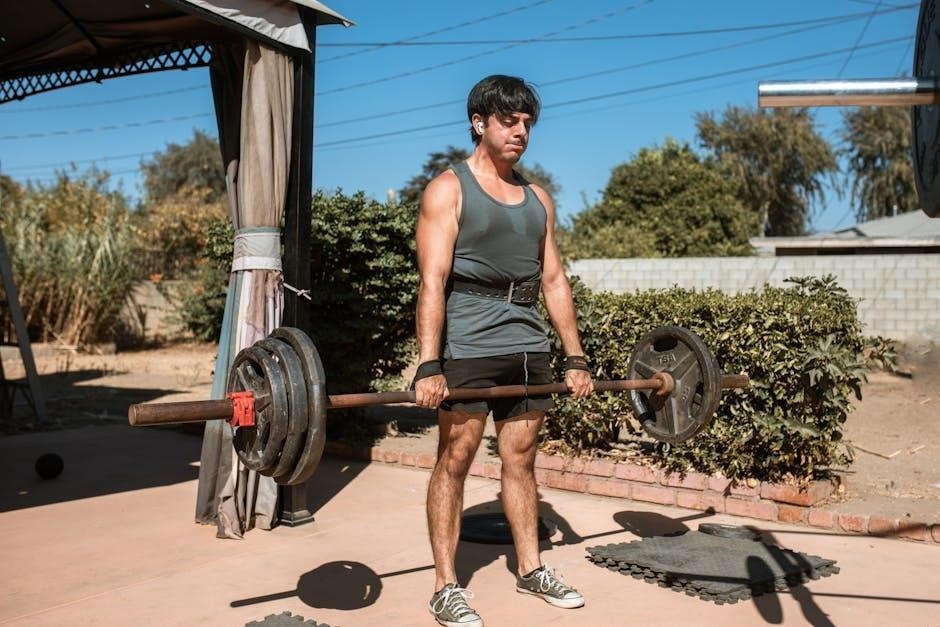Proper lifting techniques are essential for preventing injuries and promoting workplace and home safety. They emphasize using leg strength, maintaining posture, and handling loads ergonomically to reduce strain and ensure efficient lifting practices.
Why Proper Lifting Techniques Matter
Proper lifting techniques are crucial for preventing injuries, particularly back injuries, which are common in workplaces and homes. Improper lifting can lead to muscle strain, long-term health issues, and reduced productivity. By prioritizing safe lifting practices, individuals can protect their well-being, enhance workplace safety, and maintain efficiency. Ergonomics and awareness play key roles in minimizing risks and fostering a culture of safety in all environments.
The Consequences of Improper Lifting
Improper lifting can lead to severe physical harm, including back injuries, muscle strains, and musculoskeletal disorders. These injuries often result in chronic pain, medical expenses, and lost workdays. Over time, repeated poor lifting habits can cause long-term health issues, reducing quality of life and productivity. Understanding the risks highlights the importance of adopting safe techniques to protect overall well-being and maintain a safe environment.
Key Principles of Safe Lifting
Key principles include maintaining balance, using leg strength, keeping the load close, and avoiding twisting. Proper posture and grip ensure control, reducing injury risks and enhancing efficiency.
Body Positioning and Balance
Proper body positioning and balance are critical for safe lifting. Stand with feet shoulder-width apart, one foot slightly back for stability. Bend at the knees, keeping the back straight, and engage core muscles to maintain control. The load should be held close to the body to minimize strain. Avoid leaning forward or twisting, as this can lead to loss of balance and injury. Proper alignment ensures efficient lifting and reduces risk.
Grip and Hand Placement
A secure grip and proper hand placement are vital for safe lifting. Use both hands for heavy loads, ensuring a firm grasp to prevent slipping. Gloves can enhance grip on sharp or slippery surfaces. Place hands evenly around the load, maintaining consistent contact. Avoid overreaching or stretching, as this can disrupt balance. Proper hand placement ensures better control, reducing the risk of accidents and injuries during lifting tasks.

Planning the Lift
Planning ensures a safe and efficient lifting process. Assess the load’s weight, size, and path, clearing obstacles. Determine if assistance or equipment is needed beforehand to avoid risks.
Assessing the Load and Route
Before lifting, evaluate the load’s weight, size, and balance to ensure it’s manageable. Check the path for obstacles, clear stairwells, and ensure doors are wide enough. Plan the route to avoid tight spaces or hazards, reducing the need for twisting or reaching. This step is crucial for maintaining control and preventing accidents during the lift.
Using Ergonomic Equipment
Utilizing ergonomic equipment, such as manual hoists, suspension trolleys, and lift assists, can significantly reduce physical strain during lifting tasks. These tools are designed to minimize force exertion and improve control over heavy or awkward loads. By incorporating such devices, workers can safely manage lifting operations, aligning with ergonomic principles and OSHA guidelines to prevent injuries and enhance workplace safety.

The Role of Ergonomics in Lifting
Ergonomics plays a crucial role in lifting by designing tasks and workspaces to fit worker capabilities, reducing physical strain and enhancing safety through optimized techniques and equipment.
Workplace Design and Task Analysis
Workplace design and task analysis are critical in ergonomics, focusing on optimizing layouts and workflows to minimize lifting risks. Assessing tasks involves identifying hazards, such as heavy loads or awkward postures, and implementing solutions like adjustable workstations or ergonomic equipment; By evaluating the physical demands of tasks and adapting environments, employers can significantly reduce the likelihood of injuries and improve overall efficiency. Proper design ensures safer lifting practices and enhances worker well-being.
Reducing Force Exertion and Load Weight
Reducing force exertion and load weight is a key ergonomic strategy to minimize physical strain. OSHA guidelines recommend using engineering controls, such as manual hoists or adjustable workstations, to reduce lifting demands. Lightening loads or splitting tasks can also lower the risk of injury. Employers should prioritize equipment that assists in lifting, ensuring workers exert less force and maintain safe lifting practices, thereby preventing musculoskeletal disorders and enhancing workplace safety.
Safe Lifting Techniques
Safe lifting techniques involve assessing the load, using leg strength, and maintaining proper posture. Keep the object close, avoid twisting, and plan the lift to ensure efficiency and safety.
Steps for Lifting Light Objects
When lifting light objects, start by assessing the load’s weight and size. Stand close to the object with feet shoulder-width apart for balance. Bend at the knees, keeping your back straight, and grip the object firmly with both hands. Lift by straightening your legs, avoiding back strain. Keep the object close to your body and avoid twisting. Test the weight first and plan the lift to ensure smooth, safe handling.
Techniques for Heavy or Awkward Loads
For heavy or awkward loads, proper planning and teamwork are essential. Start by assessing the load’s weight and route, ensuring a clear path. Use ergonomic equipment like manual hoists or suspension trolleys to reduce strain. When lifting, position your body close to the load, grip firmly, and lift with your legs. Avoid twisting; instead, pivot your feet to maintain balance. For extremely heavy loads, consider team lifting to share the weight, ensuring each person uses proper posture and technique to prevent injury.

Training and Education
Training and education are crucial for teaching proper lifting techniques, emphasizing ergonomic practices, and ensuring regular reminders to maintain safety standards and prevent injuries effectively.
Teaching Proper Lifting Methods
Teaching proper lifting methods involves demonstrating and reinforcing safe techniques. Start by assessing the load and planning the lift. Face the object, stand with feet shoulder-width apart, and bend at the knees. Use leg muscles to lift, keep the load close to the body, and avoid twisting. Regular training and reminders ensure these practices become second nature, reducing injury risks and promoting a safer environment.
Importance of Regular Reminders and Updates
Regular reminders and updates are crucial for maintaining safe lifting practices. They reinforce proper techniques, address new challenges, and adapt to workplace changes. Employers should provide ongoing training, display safety signage, and conduct workshops to keep employees informed. This continuous education helps prevent complacency and ensures that safe lifting remains a priority, reducing the risk of injuries and enhancing overall workplace safety.
Use of Safety Equipment
Manual hoists, suspension trolleys, and personal protective equipment (PPE) are vital for safe lifting. They minimize risks and provide stability, ensuring secure handling of heavy or awkward loads.
Manual Hoists and Suspension Trolleys
Manual hoists and suspension trolleys are essential tools for safe lifting, reducing manual effort and minimizing strain. They are ideal for heavy or awkward loads, providing precise control and stability. Portable options like the Tralift can be used with fixed points or trolleys, offering versatility in various settings. Regular maintenance and proper training ensure safe and efficient operation, making them indispensable in industrial and ergonomic lifting practices.
Personal Protective Equipment (PPE)
Personal Protective Equipment (PPE) plays a crucial role in safe lifting practices by safeguarding workers from potential hazards. Safety shoes prevent slipping, while gloves provide grip and protect against sharp or rough surfaces. Additional gear like back supports and knee pads can offer extra protection, especially for heavy or awkward loads. Ensuring proper PPE usage minimizes injury risks and enhances overall safety in both workplace and home environments effectively.
Common Mistakes to Avoid
Overestimating lifting capacity, lifting with a bent back, and twisting during lifts are frequent errors. These mistakes can lead to severe injuries and musculoskeletal strain, emphasizing the need for proper technique adherence always.
Lifting with a Bent Back or Twisting
Lifting with a bent back or twisting increases the risk of back injuries and musculoskeletal disorders. Maintain a straight posture, keep the load close, and avoid sudden movements. If turning is necessary, pivot with your feet instead of twisting your torso to prevent strain on your spine and ensure safer lifting practices overall.
Overestimating One’s Lifting Capacity
Overestimating your lifting capacity can lead to severe injuries and accidents. Always assess the load’s weight and your physical limits beforehand. If unsure, seek assistance or use ergonomic tools to reduce strain. Prioritizing safety by acknowledging personal limitations ensures a healthier and more secure lifting environment for everyone involved, both at work and at home.

Legal and Safety Standards
Adherence to OSHA guidelines and industry-specific protocols ensures compliance with safety regulations, reducing workplace injuries and promoting a secure environment for all employees and tasks.
OSHA Guidelines for Safe Lifting
OSHA guidelines emphasize assessing tasks, using engineering controls like hoists, and reducing force exertion. Employers must train employees on proper techniques, ensuring workplaces are ergonomically designed. These standards aim to prevent injuries by promoting safe lifting practices, applicable in both industrial and home settings to safeguard health and productivity.
Industry-Specific Safety Protocols
Industry-specific safety protocols tailor lifting practices to unique workplace demands, ensuring compliance with OSHA standards. For example, construction sites may require rigging equipment, while healthcare settings focus on patient handling aids. These protocols adapt general lifting techniques to specific risks, ensuring safety and efficiency across diverse operational environments and tasks.

Real-Life Applications
Proper lifting techniques apply to both industrial and home environments, reducing injury risks and enhancing efficiency through planned, ergonomic practices.
Proper Lifting in Industrial Settings
In industrial environments, proper lifting techniques are critical to prevent injuries and enhance productivity. Employers should ensure workers are trained in ergonomic practices, such as assessing loads, using manual hoists, and maintaining clear pathways. Personal protective equipment (PPE) like gloves and safety shoes is essential. Regular reminders and updates on lifting methods help maintain safety standards, reducing the risk of accidents and promoting a healthier workplace culture.
Safe Lifting Practices at Home
Adopting safe lifting practices at home can significantly reduce the risk of injury. Start by assessing the load’s weight and planning the route. Bend at the knees, keep the object close to your body, and avoid twisting. Use ergonomic tools or seek assistance for heavy items. Teaching family members proper techniques ensures everyone stays safe during household tasks, fostering a culture of safety and responsibility at home.
Proper lifting techniques are vital for long-term safety and health. Consistent practice and education ensure lasting benefits, while advancements in ergonomics and technology continue to enhance lifting safety and efficiency.
Best Practices for Long-Term Safety
Consistent practice and education are key to long-term safety. Always assess loads, use ergonomic equipment, and apply proper lifting techniques to avoid injuries; Regular reminders and updates ensure habits remain strong. Encourage a culture of safety by sharing knowledge and promoting teamwork. Over time, proper lifting becomes second nature, reducing risks and enhancing overall efficiency in both workplace and home environments.
The Future of Lifting Techniques and Technology
Advancements in ergonomics and technology are revolutionizing lifting techniques. Emerging tools like exoskeletons and AI-powered lift assistants aim to reduce physical strain. These innovations, combined with improved training methods, promise to enhance safety and efficiency. The integration of smart devices and wearable tech will provide real-time feedback, helping users maintain proper form and prevent injuries. Such advancements will make lifting safer and more efficient across industries and households.